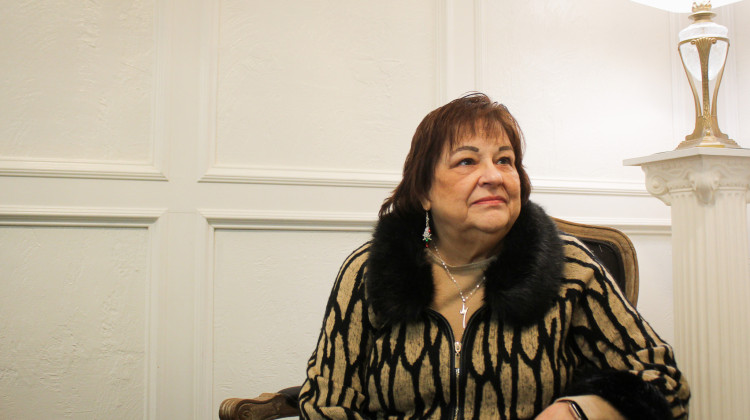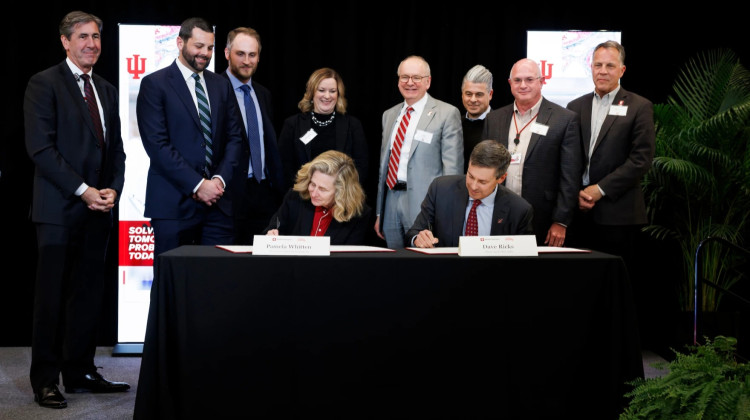
Gov. Eric Holcomb ceremonially signs SB4, the public health system overhaul bill, on Wednesday, May 24, 2023. Supporters of the law, including former Sen. Luke Kenley and State Health Commissioner Dr. Kristina Box (directly behind and to the right of Holcomb), look on.
Brandon Smith/IPB NewsOne of 2023’s signature bills overhauls Indiana’s public health system. For the first time, local health departments can get significant money from the state to provide dozens of core health services.
Getting that bill to the finish line was something many thought wasn’t possible. How did the measure become law – and what’s left to do now?
Gov. Eric Holcomb announced the creation of a Public Health Commission in the summer of 2021. He tasked it with studying the state’s public health system and developing recommendations to strengthen it.
Shortly thereafter, commission leaders met with local public health officials to lay out what they hoped to accomplish. Former state Sen. Luke Kenley, a co-chair, said he then asked those nearly 100 local officials to raise their hands if they thought the effort would be successful.
Three of them did.
“I was shocked,” Kenley said. “And I thought, surely the local health department people, this is their bread and butter, surely they believe in this. But they had become so used to being defeated at every turn.”
That pessimism was likely justified. State lawmakers had just spent the previous session stripping power away from local health departments in response to conservatives’ anger over handling of the COVID-19 pandemic.
Kenley said some legislators’ reactions to this initiative were sharply negative. He described a meeting with a conservative senator, early in the process.
“I just went to his hometown, had lunch with him and laid it out on the table,” Kenley said. “And he virtually blew his brains out at the idea that I would even discuss this.”
State Health Commissioner Dr. Kristina Box had similar experiences, with many legislators balking at the push to bolster the local agencies.
“Yeah, I think there was a generalized fear amongst our legislators and probably even our local elected officials to begin with … that we as a state were trying to come in and take over public health, and that we were trying to tell local government what to do and that we were using money as kind of a way to control them,” Box said.
Knox County Board of Commissioners President Kellie Streeter had that concern, initially. Streeter is also vice president of the Indiana Association of County Commissioners. And she’s the administrator of the local health department in her neighboring Daviess County.
“Knox and Daviess share a border and are extremely unique in the public health needs,” Streeter said. “So, it became a concern. Is the state telling us how to operate locally?”
Commission leaders and lawmakers worked hard to alleviate those fears, making the legislation explicit that no such takeover was happening.
One of the ways it does that is take the decision to buy into the program away from local health departments and put it in the hands of local elected officials.
Streeter said that sets up a scenario where a county’s health leaders want the program – and its politicians say no.
“I believe that there's still some lingering pandemic sentiment that has created some barriers between elected commissioners and the public health department that still have to heal,” Streeter said. “So, I do recognize that politics play all around me.”
While the measure passed with broad, bipartisan support, the road through the General Assembly wasn’t easy. Late in the process, House Republicans added a floor amendment that created a task force to investigate the use of government power during the COVID-19 pandemic.
Box said that was a low point.
“It was a difficult time for us because we were in the process of wanting to move forward and to work with our partners and to show people really what this monumental step could mean for the state of Indiana,” Box said. “We felt like a lot of that was settled in our court system, and we really wanted this to be a positive joining of all of our partners across the state to make sure that every Hoosier will have that same access to core public health services,” Box said.
The task force was ultimately removed from the bill before it reached the governor’s desk.
Streeter helped the overall effort, too, talking individually with county commissioners across Indiana.
Still, she acknowledged that some just didn’t come around.
“I think some are opting out just to see how the next year to two years go,” Streeter said. “I think some are just fervently against it … and it's based upon a narrative of anti-COVID, anti-pandemic policy of the governor. So, that's not going to change. And then you're going to have the majority that opt in.”
A strong majority of counties have expressed interest in the program.
But that raises a separate issue – funding. The commission’s recommendations came with a big price tag: $480 million over two years. Legislative leaders immediately pushed back, and the administration lowered the ask: $347 million in the new state budget.
Kenley is a former Senate budget architect – and there are few people who like spending government money less than he. But the Republican was convinced such investment was needed.
“The general statistics of where Indiana ranks were pretty devastating and pretty embarrassing,” Kenley said. “The need is so apparent and so appalling in terms of how much blue sky we have, how much we can do.”
Still, lawmakers didn’t deliver even the revised request, choosing instead to spend $225 million – a number that does concern Kenley.
“I'm worried that we don't quite have enough money, if everybody signs up the first year, to make it work,” Kenley said.
Still, it’s unlikely every county will initially agree to the program, and Dr. Box said this is a great start.
“The bottom line is, they were getting $6.9 million a year divided amongst 94 [local health departments] before that,” Box said. “So, if we can't make significant improvements with this, then we went wrong somewhere in the implementation – which is not going to happen.”
Join the conversation and sign up for the Indiana Two-Way. Text "Indiana" to 73224. Your comments and questions in response to our weekly text help us find the answers you need on statewide issues.
Implementation is now the monumental task facing local health departments and the state, led by new State Health Commissioner Dr. Lindsay Weaver. She said that work already started a year ago.
“We already started planning for, what does implementation look like?” Weaver said. “How are we going to do exactly what you just said – show that this money is needed, it's important.”
Data is the key. Weaver said the state and locals are developing performance indicators to show progress – and those will look different in each county.
“So, we heard from one county, we have a high rate of drownings in our young people. So, they want to implement a program there,” Weaver said. “Another county, we continue to have fatalities and injuries from kids not properly restrained in car seats. So, what programming can we build out there?”
Streeter said local communities will be active partners in deciding the performance indicators. And she said some of the work is education – getting Hoosiers to understand what health departments can offer them.
“In Knox County, one of the greatest issues we fight is hypertension and diabetes. Do you think of the health department when you think of these two things?” Streeter said. “No, you think of your doctor and your hospital. But people can't get in there to get regular care. So, where do they go? We could look at, in our community, starting clinics, starting weekly things to keep it managed.”
Realistically, they don’t have a lot of time to show the program’s impact. After all the hard work to create the overhaul, and now all the hard work to implement it, they’ll have to go back to lawmakers in just a year and a half to prove all over again why it needs funding.
Brandon is our Statehouse bureau chief. Contact him at bsmith@ipbs.org or follow him on Twitter at @brandonjsmith5.
9(MDAyMzk1MzA4MDE2MjY3OTY1MjM5ZDJjYQ000))
 DONATE
DONATE








 Support WFYI. We can't do it without you.
Support WFYI. We can't do it without you.